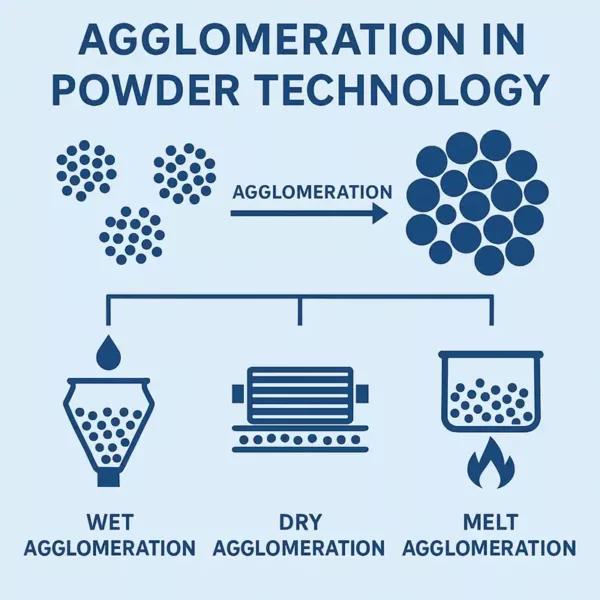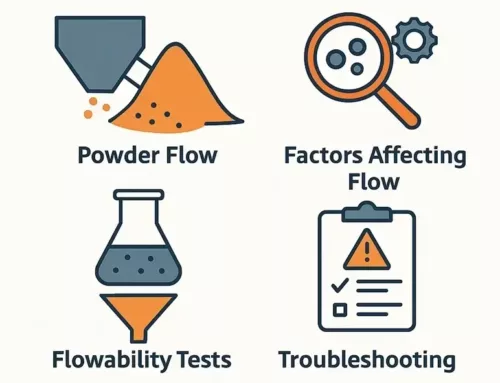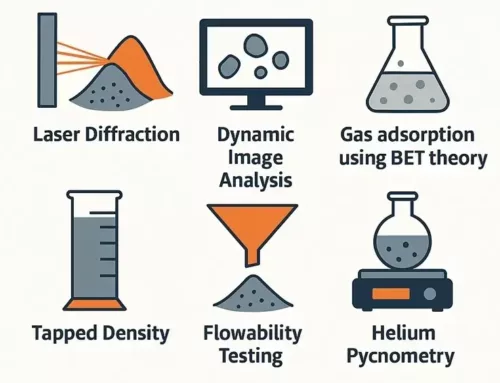Table of Contents of agglomeration in powder technology

- Introduction to Agglomeration in powder technology
Agglomeration plays a foundational role in powder technology. It transforms fine particles into larger, more manageable structures. As a result, agglomerates improve flow, reduce dust, and enhance functionality across a wide range of industries.
In this guide, we first define agglomeration and explain why it matters. Then, we describe how industries carry out the process and where they apply it most effectively. Along the way, you will discover wet and dry methods, common equipment types, key process parameters, and important industry-specific benefits.
2. Why Agglomeration Matters
Fine powders often challenge industries by making handling, storage, and processing inefficient. However, agglomeration solves these problems by creating larger, more uniform particles with predictable behavior.
Key benefits of agglomeration include:
-
Improved flowability: Larger particles reduce interparticle friction and allow powders to move more easily.
-
Better handling: Less dust, easier transport, and fewer segregation issues enhance operational safety and boost efficiency.
-
Enhanced compressibility: Stronger powders support processes like tablet pressing and pelletizing more effectively.
-
Controlled dissolution: This feature delivers a critical advantage for instant food products and pharmaceutical formulations.
-
Increased bulk density: Denser materials optimize packaging, improve shipping efficiency, and maximize reactor volume usage.
Together, these advantages stabilize processing operations, reduce production risks, and ensure consistent end-product quality across multiple industries.
3. Types of Agglomeration in powder technology
3.1 Wet Agglomeration
Wet agglomeration forms granules by adding a liquid binder to fine powder particles. Industries widely use this method when they need to improve particle size and flowability.
The typical wet agglomeration process follows these steps:
-
Binder application: Operators spray or mix the liquid binder with the powder to initiate granule formation.
-
Granule growth: Nuclei form and grow through a layering or coalescence mechanism, strengthening the structure.
-
Drying stage: The system carefully dries the agglomerates to achieve final hardness and ensure structural stability.
Common industries that use wet agglomeration include:
Food production, detergent manufacturing, and pharmaceutical granulation processes.
Typical equipment used for wet agglomeration includes:
High-shear granulators and fluidized bed agglomerators, selected based on the product characteristics and process requirements.
3.2 Dry Agglomeration
Dry agglomeration methods rely on mechanical pressure rather than using a liquid binder. As a result, they are ideal for processes where moisture must be avoided.
The typical dry agglomeration process includes:
-
Compression: The powder is compressed into ribbons or flakes using mechanical force.
-
Granulation: The flakes are then milled into granules of the desired size and consistency.
-
Final step: No liquid drying phase is needed, which simplifies the overall process and saves energy.
Dry agglomeration is commonly used in:
Pharmaceutical production, fertilizer manufacturing, ceramics processing, and battery material preparation.
Equipment examples frequently used for dry agglomeration include:
Roller compactors and briquetting presses, chosen based on product specifications and production volume.
3.3 Melt Agglomeration
Melt agglomeration uses heat to melt a binder that is already present in the powder blend. Consequently, this method eliminates the need for additional liquid binders during processing.
The typical melt agglomeration process involves:
-
Heating the mixture: The powder blend is gently heated to activate the binder.
-
Binder melting and agglomeration: As the binder melts, agglomerates form through particle adhesion.
-
Cooling stage: The agglomerates are cooled to solidify their structure and lock in the desired properties.
Melt agglomeration is typically used in:
Heat-tolerant formulations, specialty food applications, and pharmaceutical products where precise control over structure is essential.
4. Agglomeration Equipment
Selecting the right equipment is crucial for successful agglomeration. Indeed, different applications require different systems tailored to specific needs. In most cases, the best equipment choice depends on powder properties, binder type, and desired granule characteristics.
Key types of agglomeration equipment include:
-
High-shear mixers: Enable fast granule formation, making them ideal for producing dense agglomerates.
-
Fluidized bed agglomerators: Provide uniform drying with low product stress, supporting delicate formulations.
-
Disc or drum pelletizers: Create larger, rounder granules and are well-suited for bulk production needs.
-
Roller compactors: Rely on mechanical pressure for dry agglomeration, with no liquid binders required.
-
Extruders: Deliver shape-controlled agglomeration with highly consistent output across batches.
Ultimately, each tool provides targeted control over particle size, shape, and production throughput, ensuring the final product meets both technical and operational requirements.
5. Process Parameters to Control
Tight process control is essential to achieve repeatable results and maintain high product quality during agglomeration. Small variations in process parameters can significantly impact the characteristics of the final agglomerates.
Key parameters to monitor and optimize include:
-
Binder type and dosage: These directly influence agglomerate strength, porosity, and overall durability.
-
Feed rate: This affects both particle size distribution and system load, impacting granule uniformity and process stability.
-
Mixing intensity: Proper mixing promotes uniform granule growth and ensures homogeneity across the batch.
-
Temperature and humidity: These are critical factors, particularly in wet and melt agglomeration, where moisture control is vital.
-
Drying conditions: They determine final hardness, minimize shrinkage, and reduce friability, ensuring robust agglomerates.
By carefully controlling and continuously optimizing these parameters, manufacturers can achieve consistent product quality, improve process efficiency, and reduce production variability.
6. Quality Testing of Agglomerated Powders
Once agglomeration is complete, thorough testing is essential to ensure the product meets all technical requirements. Without proper validation, inconsistencies can arise that affect downstream processes and final product performance.
Common tests include:
-
Particle size distribution: Measured using laser diffraction or sieve analysis, it confirms uniformity and consistency across batches.
-
Bulk and tapped density: Critical for efficient packaging, storage, and process control, especially in large-scale operations.
-
Flowability: Evaluated through methods such as the angle of repose, Hausner ratio, or specialized flow meters, ensuring reliable material handling.
-
Mechanical strength: Assessed using compression or friability tests to determine the durability of agglomerates during transport and usage.
-
Dissolution behavior: Particularly important in food and pharmaceutical applications, where controlled release and bioavailability are key factors.
Together, these metrics not only guide process optimization but also validate the agglomerated product’s suitability for its intended use, ensuring quality, efficiency, and customer satisfaction.
7. Applications by Industry
Agglomeration plays a vital role across many industries. Below, we explore how different sectors apply it:
| Industry | Application |
|---|---|
| Food | Instant beverages, milk powder, cocoa, spices |
| Pharmaceuticals | Granulation for tablet pressing, inhalable powders |
| Detergents | Low-dust powders, controlled dissolution |
| Chemicals | Pigment granules, fertilizers, catalysts |
| Materials | Powder metallurgy, 3D printing feedstocks |
Tailoring the process to each product ensures functionality, compliance, and better performance.
8. Common Challenges and Troubleshooting
Like any complex process, agglomeration presents several potential challenges that must be carefully managed. For instance, over-wetting can cause sticky build-up or result in oversized clumps that disrupt flow and consistency. Conversely, under-wetting often leads to excessive dust formation and the production of weak, fragile agglomerates.
Additionally, binder migration during the process can lead to uneven granulation, affecting both quality and performance. Breakage during handling is another concern, as it reduces overall product yield and increases material waste. Furthermore, fouling or clogging within equipment can significantly slow down throughput, impacting production schedules.
Fortunately, most of these issues can be effectively resolved by adjusting critical parameters such as binder dosage, mixing speed, or equipment settings. With proper monitoring and timely intervention, agglomeration processes can be kept stable, efficient, and highly productive.
9. Agglomeration and Sustainability
Agglomeration contributes significantly to more sustainable processing in several important ways. First, it helps reduce airborne dust and minimize product loss, leading to safer workplaces and cleaner environments. Furthermore, by improving energy efficiency in downstream handling and transport, agglomeration supports overall process optimization.
In addition, it allows for the reuse of fines or process scrap, which would otherwise be wasted, thereby enhancing material utilization. Agglomeration also enables controlled release and precise dosing in finished goods, a critical factor in industries such as food, pharmaceuticals, and chemicals.
Together, these benefits strongly support circular economy goals while simultaneously promoting cleaner, more responsible production practices across multiple sectors.
10. Summary of agglomeration in powder technology
Agglomeration plays a key role in powder processing by delivering crucial improvements in flow, safety, and overall performance. It solves many handling and processing challenges by transforming fine particles into larger, more manageable structures. Whether industries apply wet, dry, or melt methods, agglomeration allows powders to function reliably, even under demanding industrial conditions.
Moreover, selecting the right method, equipment, and process controls ensures consistent product quality and high manufacturing efficiency. Every step — from choosing a binder to optimizing drying conditions — directly influences the final outcome. As a result, agglomeration has become an indispensable tool in modern powder technology, supporting industries that demand precision, reliability, and scalability.
The European Federation of Chemical Engineering (EFCE) actively promotes research and advances best practices in agglomeration techniques. Through their initiatives, industries continue to improve powder processing methods and achieve more consistent, efficient results.




